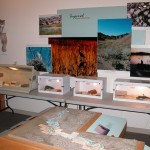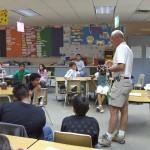Living and meshing with others is one aspect of volunteer life on a refuge. The other is work.
As soon as we made our site liveable for the next several months at Imperial National Wildlife Refuge, we met with Outdoor Recreation Planner/Volunteer Coordinator Sue McDonald to discuss our duties for the required three-day work weeks.

We already knew that we would man the visitor center one day a week and that the other two days would be spent as naturalists on the trail and in the Yuma classrooms. “You can exhibit your snakes here,” Sue said after setting up a large table in the display area of the visitor center.
For transporting, our snakes ride inside a red cooler, each in its own bag similar to a pillowcase. The cooler’s insulation maintains an even temperature that keeps the snakes comfortable, while the bags allow each snake security. Chuck set up our four cages on the table Sue prepared, created a habitat in each, and placed each snake in its own environment. Here they would reside for the duration of our commitment at Imperial.
First Group
It wasn’t long before the first school group arrived for a hike on the Painted Desert Trail, Imperial’s only designated trail. While we had led many school tours at the Denver Zoo, guiding children on a trail in a remote area was a new experience for us. Perhaps because children in Yuma have fewer opportunities, they relish those that they receive. None complained of fatigue, hunger, or boredom on the trail. Greater attention spans and awe from these children surprised us.

Shortly after that 2005-6 school year started, however, Sue learned that many schools that year were unable to send buses to travel Red Cloud Mine Road, the remote dirt road leading to the Painted Desert Trail. School visits would be limited.
“I don’t know if I’ll have enough for you to do,” she told us. Then, thinking of the snakes, she added, “You’ve got a pre-packaged snake program. Maybe you can take that to the schools.”
After creating a small poster describing our program, Sue sent it to schools throughout Yuma. Response was immediate and positive. While a few schools might still visit the Refuge, others invited us to present our program at school. Our schedule quickly filled.
Hold This
As our supervisor, Sue accompanied us on our first presentation to observe and evaluate our program. We appreciate any constructive criticism that can improve our skills, and we welcomed her involvement.
Halfway through the program, Chuck held Hatch the bullsnake, demonstrating how a constrictor can wrap around a hand merely to hold on. “She’s not hurting me,” he told the class. “But she has nothing else to hold on with but her body. She knows I’m too big to eat, so she’s not squeezing too hard.”
As he talked, I removed Spike the kingsnake from his bag to prepare him to be touched by eager fingers. When Chuck finished, he asked for help bagging Hatch. Needing two hands, I turned to Sue. “Hold Spike for a minute,” I said as I handed her the snake.

Sue’s eyes widened, but she reached out and gently received Spike in her hands. “I’ve never touched a snake before!” she said. Her admission surprised me — I assumed all rangers and wildlife people were accustomed to handling snakes and other animals.
As she watched the long black and white body slowly wind through her fingers and coil into her hands, Sue relaxed and became fascinated with the soothing undulations and soft skin of the strange animal she held. By the time I’d finished helping Chuck and returned to her, Sue wasn’t ready to give Spike back. “I think I’m bonding with Spike!”
We smiled at Sue’s success. It was success for us as well. Our programs and work with snakes aim to exchange anxiety about this creature for appreciation for their place in the world. We don’t expect everyone to like snakes, but we hope to instill respect and understanding for a misunderstood animal.
